Water resistance ratings are essential for determining how well a watch or electronic device can endure exposure to water, measured in meters. These ratings are established through standardized testing methods that evaluate a product’s performance under different depths and pressures, helping consumers make informed decisions about their suitability for various water-related activities.
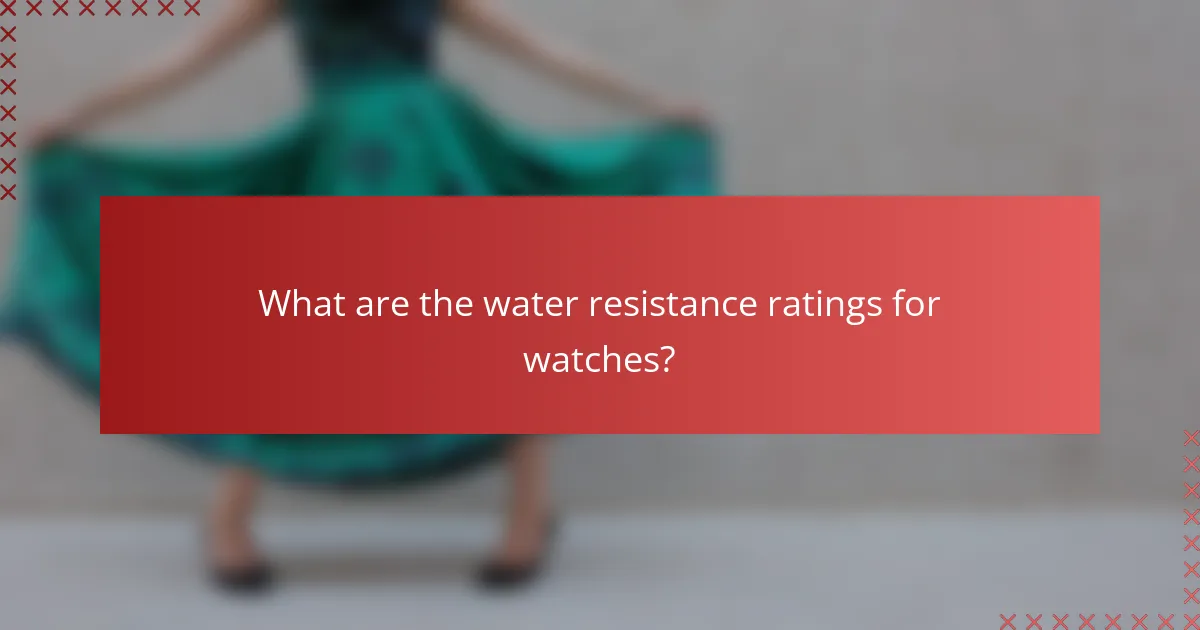
What are the water resistance ratings for watches?
Water resistance ratings for watches indicate how well a watch can withstand exposure to water. These ratings are measured in meters and provide guidance on the watch’s suitability for various water-related activities.
Waterproof up to 30 meters
A watch rated as waterproof up to 30 meters is suitable for everyday use, including splashes of water and brief immersion. However, it is not designed for swimming or diving. Users should avoid pressing buttons while the watch is submerged.
Common activities for this rating include washing hands or light rain exposure. It’s advisable to keep the watch away from water sports to prevent damage.
Water-resistant up to 100 meters
Watches rated for water resistance up to 100 meters can typically handle swimming and snorkeling. This level of resistance means the watch can withstand water pressure at depths of around 10 atmospheres.
While suitable for most water activities, it’s still wise to avoid diving or prolonged exposure to water. Regular maintenance checks can help ensure the seals remain intact and effective.
Diving watches rated for 300 meters
Diving watches with a rating of 300 meters are specifically designed for professional diving. They can withstand high water pressure and are equipped with features like rotating bezels and helium escape valves for deep-sea conditions.
These watches are ideal for serious divers and can endure extended periods underwater. Users should still ensure proper care and servicing to maintain their water resistance over time.
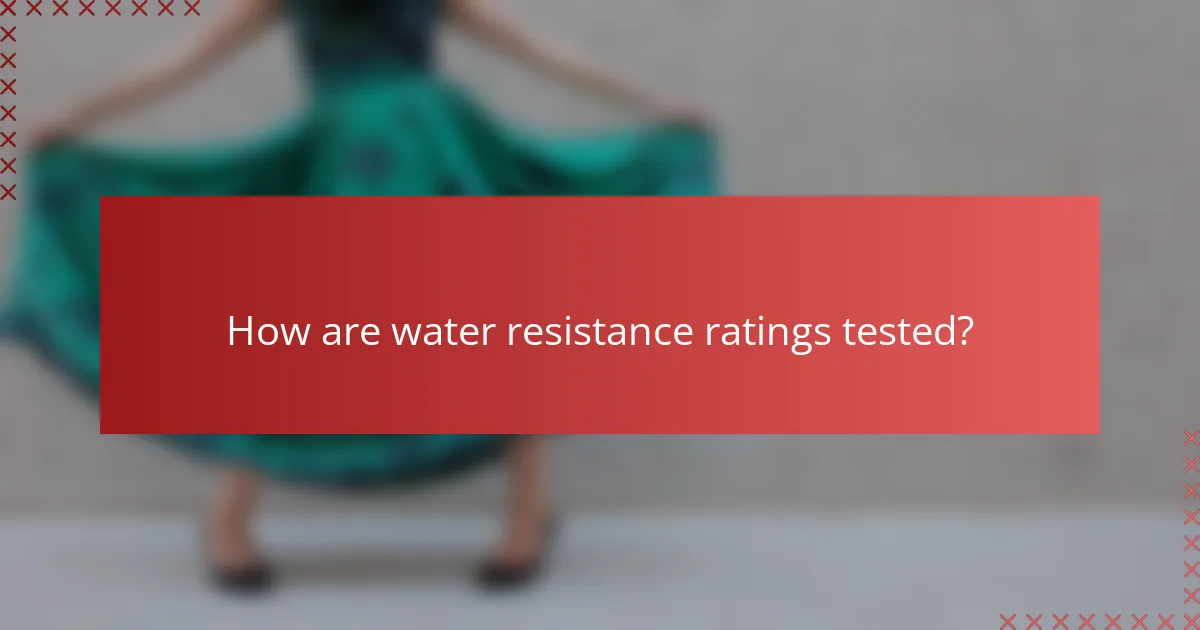
How are water resistance ratings tested?
Water resistance ratings are tested through standardized methods that assess a product’s ability to withstand water exposure at various depths and pressures. These tests help consumers understand how well a device, such as a watch or smartphone, can handle water without damage.
ISO 22810 standard for water resistance
The ISO 22810 standard outlines the testing procedures for water resistance in watches, specifying conditions under which a watch can be deemed suitable for shallow water activities. This includes exposure to splashes and brief submersion, typically up to 10 meters (about 33 feet).
Watches that meet this standard are generally safe for swimming and snorkeling but are not recommended for diving or high-pressure water activities. Always check the specific rating to ensure it aligns with your intended use.
Pressure testing methods
Pressure testing methods involve submerging a product in water at specific depths while measuring the pressure exerted on it. This simulates real-world conditions and helps determine the maximum water resistance level.
Common methods include static pressure tests, where the device is submerged at a fixed depth, and dynamic tests that simulate movement through water. Each method provides insights into how the product will perform under different scenarios, helping consumers make informed choices.
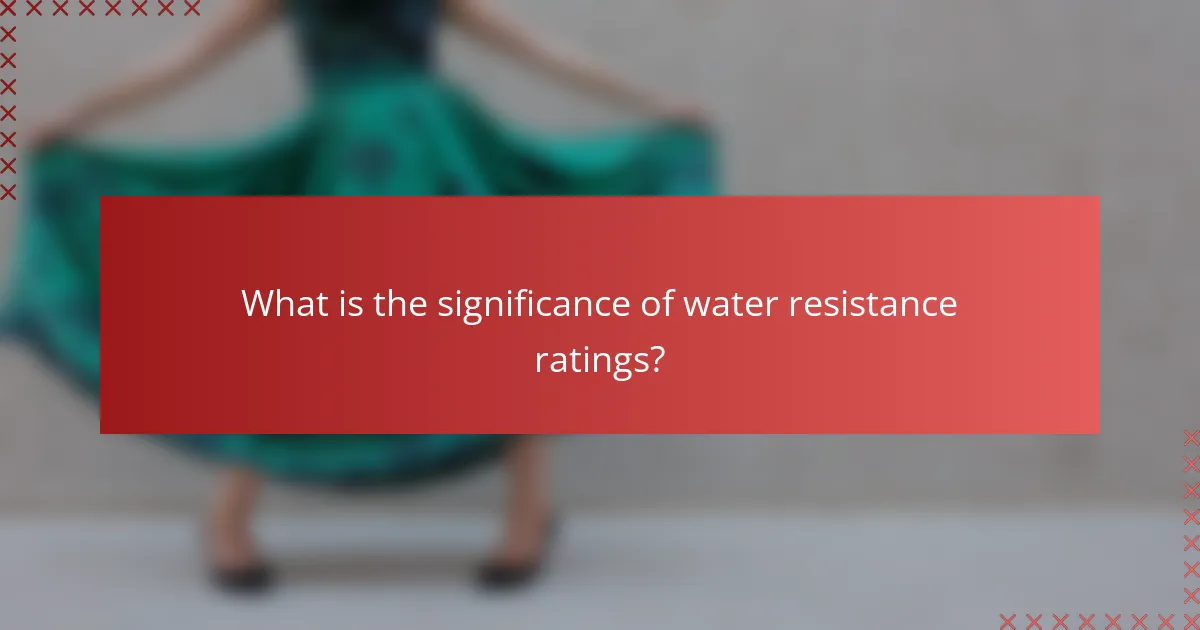
What is the significance of water resistance ratings?
Water resistance ratings indicate how well a device can withstand exposure to water, which is crucial for protecting electronics and watches from damage. These ratings help consumers understand the limits of their devices in various environments, ensuring informed choices based on their needs.
Protection against water damage
Water resistance ratings provide a measure of protection against potential water damage, which can be costly to repair. Devices are often tested according to standards like the IP (Ingress Protection) rating, which ranges from IPX0 (no protection) to IPX8 (protection against continuous immersion). Understanding these ratings helps users select devices that can endure specific conditions, such as rain or submersion.
For example, a watch rated at 50 meters can typically withstand splashes and brief immersion, while a rating of 100 meters indicates suitability for swimming. However, actual performance may vary based on factors like temperature and wear, so it’s wise to avoid pushing the limits of these ratings.
Guidance for consumer usage
When selecting devices based on water resistance ratings, consider your typical usage scenarios. For daily wear, a device with a rating of at least IP67 is advisable, as it can handle dust and immersion in water up to 1 meter for 30 minutes. For outdoor activities, look for higher ratings that offer more robust protection.
Additionally, always check the manufacturer’s guidelines regarding water exposure. Avoid exposing devices to hot water or high-pressure water jets, as these conditions can exceed the rated limits and lead to damage. Regularly inspect seals and gaskets for wear, as these components are critical for maintaining water resistance over time.

How do water resistance ratings differ by brand?
Water resistance ratings can vary significantly between brands due to differences in testing standards and design philosophies. Each manufacturer may use distinct criteria to determine how well their watches can withstand water exposure, leading to variations in performance and reliability.
Rolex Submariner vs. Seiko Prospex
The Rolex Submariner is renowned for its robust water resistance, typically rated at 300 meters (1,000 feet), making it suitable for professional diving. Its construction features a helium escape valve and a screw-down crown, enhancing its durability under pressure.
In contrast, the Seiko Prospex series offers a range of water resistance ratings, often starting at 200 meters (656 feet) for models designed for recreational diving. While still reliable, the Prospex may not match the extreme depths of the Submariner, but it provides excellent value for casual divers and everyday wear.
Casio G-Shock water resistance features
Casio G-Shock watches are known for their exceptional durability and water resistance, often rated up to 200 meters (656 feet) or more. These watches are designed to withstand harsh conditions, making them ideal for outdoor activities and sports.
Many G-Shock models incorporate additional features such as shock resistance and mud resistance, enhancing their overall reliability. Users should consider the specific model’s water resistance rating and intended use, as some models may be better suited for swimming while others excel in extreme sports.
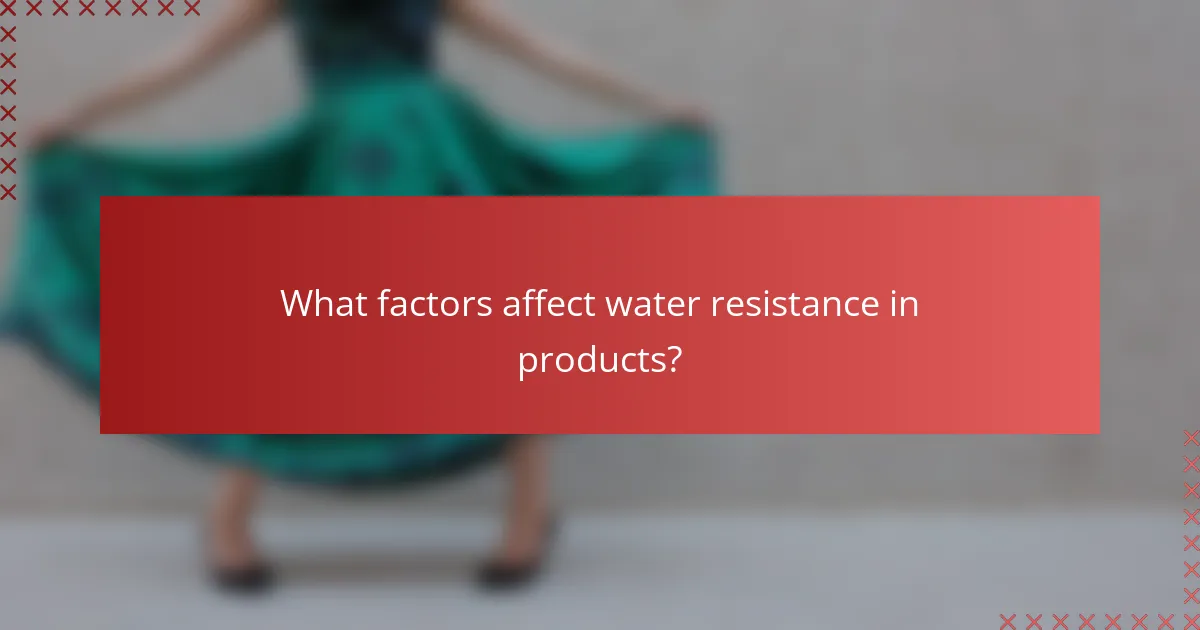
What factors affect water resistance in products?
Water resistance in products is influenced by several key factors, including the quality of materials used, the effectiveness of seals, and the item’s age. Understanding these factors can help consumers make informed choices about the durability and longevity of water-resistant products.
Material quality and seals
The materials used in a product significantly impact its water resistance. High-quality materials, such as silicone or rubber, provide better sealing against water ingress compared to lower-grade alternatives. Additionally, the design and integrity of seals, such as gaskets and O-rings, are crucial; any imperfections can lead to leaks.
When evaluating water-resistant products, look for those that meet established standards, such as IP ratings, which indicate the level of protection against water and dust. For example, an IP67 rating means the item can withstand immersion in water up to 1 meter for 30 minutes.
Age and wear of the item
The age and condition of a product can significantly affect its water resistance. Over time, seals can degrade, materials may become brittle, and protective coatings can wear off, reducing the item’s ability to repel water. Regular inspection and maintenance are essential to ensure continued effectiveness.
To prolong the water resistance of your items, avoid exposing them to extreme conditions and follow manufacturer care instructions. If you notice signs of wear, such as cracks or frayed seals, consider replacing the item or seeking professional repair to maintain its protective qualities.
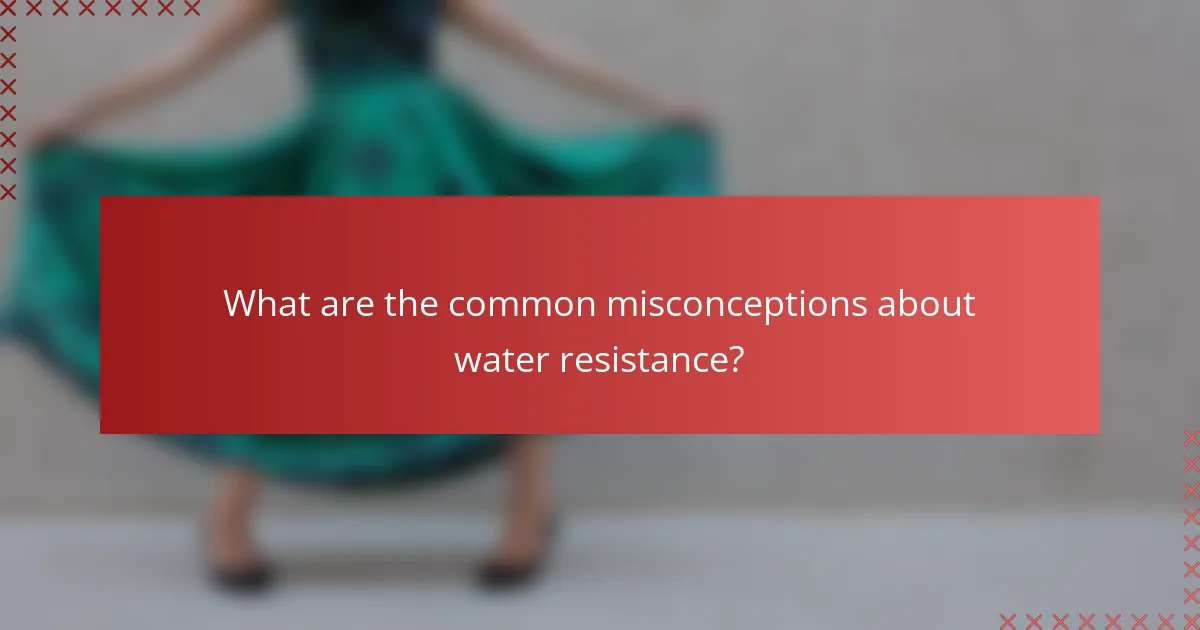
What are the common misconceptions about water resistance?
Many people confuse water resistance with waterproofing, leading to misunderstandings about what products can withstand water exposure. Additionally, depth ratings often mislead consumers regarding the actual performance of items in water.
Misunderstanding depth ratings
Depth ratings indicate how deep a device can be submerged in water for a specific duration without damage. For instance, a watch rated for 50 meters may only be suitable for splashes or brief immersion, not for prolonged underwater use. Always check the manufacturer’s guidelines for practical usage limits.
Common ratings include 30 meters for splash resistance, 50 meters for swimming, and 100 meters or more for diving. However, these figures do not translate directly to actual depths; they reflect testing conditions, often in static water, which may not account for dynamic situations like waves or movement.
Assuming all water-resistant items are waterproof
Water-resistant items can handle some exposure to moisture but are not impervious to water. For example, a water-resistant jacket may repel light rain but could fail in heavy downpours. It’s crucial to understand the specific rating and intended use of each item.
To avoid disappointment, always verify the level of water resistance before assuming an item is waterproof. Look for clear labeling and user reviews that detail real-world performance, especially for products like electronics or outdoor gear that may be exposed to water frequently.
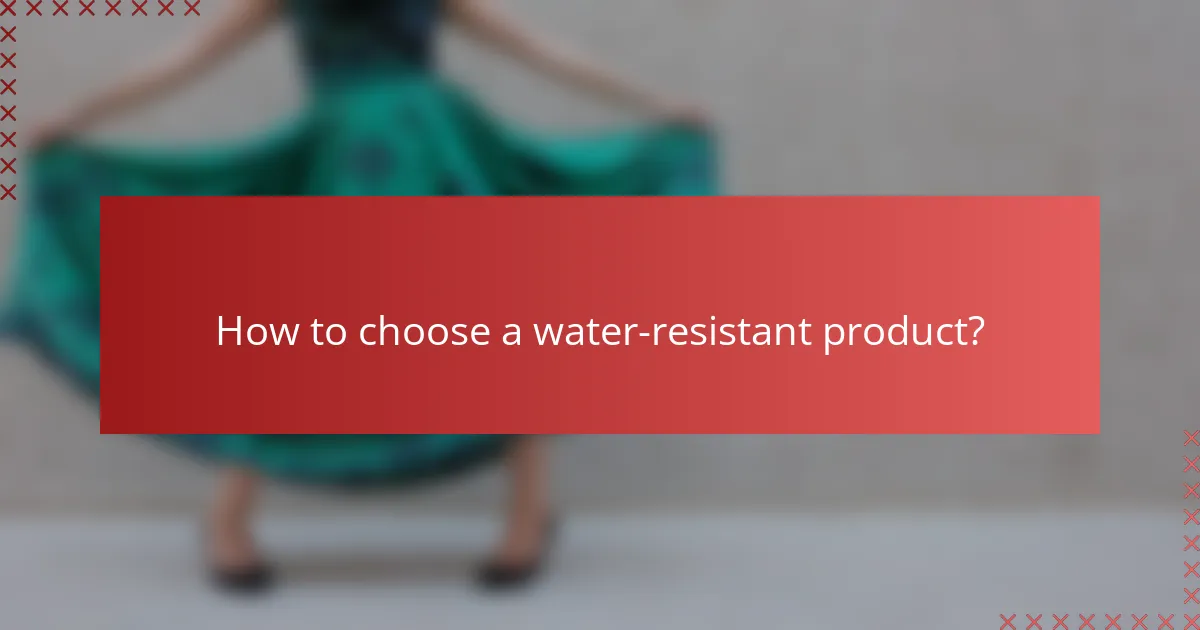
How to choose a water-resistant product?
Choosing a water-resistant product involves understanding its intended use and the specific water resistance ratings. Look for products that meet your activity requirements, whether it’s for casual use, swimming, or professional diving.
Assessing intended use and activities
Start by identifying the activities you plan to engage in with the product. For instance, if you need a watch for swimming, look for a water resistance rating of at least 50 meters. For diving, consider products rated for 100 meters or more.
Consider the environment as well. If you’ll be exposed to saltwater, ensure the materials are corrosion-resistant. For everyday use, a lower rating may suffice, but keep in mind that higher ratings often provide better durability against accidental exposure.
Finally, check the manufacturer’s guidelines for water resistance testing standards. Products may vary in performance based on how they were tested, so understanding these details can help you make an informed decision.
